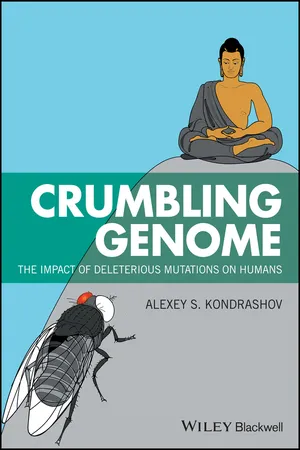Biological Sciences
Genotype
Genotype refers to the genetic makeup of an organism, including the specific combination of alleles for a particular trait. It represents the inherited instructions encoded in an organism's DNA that determine its characteristics and potential for development. Genotype plays a crucial role in shaping an organism's phenotype, or observable traits, through interactions with the environment.
Written by Perlego with AI-assistance
Related key terms
7 Key excerpts on "Genotype"
- eBook - ePub
Knowledge of Life Today
Conversations on Biology (Jean Gayon interviewed by Victor Petit)
- Jean Gayon, Victor Petit(Authors)
- 2019(Publication Date)
- Wiley-ISTE(Publisher)
In this second work, which is of crucial importance in the history of genetics, Johannsen simultaneously introduced the terms “gene”, “Genotype” and “phenotype”. “Gene” was to be the new name of Mendel’s “characteristic”, with the capacity to exist in several states (alleles). “Genotype” denoted a particular genetic combination of alleles, defined for one or more characteristics (for example AA, Aa or aa in the case of single genes; AABB, AaBB or AaBb in cases of two genes, and so on for increasing numbers of genes). Taken to its fullest extent, the full Genotype is the entire genetic makeup of an individual. “Phenotype” denoted the visible manifestation of a given Genotype, and the two concepts were inextricably linked: Genotypes become manifest in phenotypes, and specify the subjacent hereditary composition of the phenotype. My point here is that the earlier statistical and purely descriptive definition of a type (pure lines) came to be replaced by a structural definition, in which the Genotype was defined as a genetic composition. Clearly, Genotypes may become manifest in a variety of ways, depending on the conditions of the milieu, but its definition is, in a way, independent of these conditions. In epistemological terms, there is no contradiction between the biometric and genetic approaches to heredity: the two visions are complementary. However, the genetic approach undoubtedly offered a remarkable reformulation (and reconstruction) of the soma/germen distinction proposed by August Weismann three decades earlier: the former effectively replaced the latter, as Thomas Kuhn put it. 3.1.4. History of genetics in France 31 Since you met Richard Burian, much of your work has focused on the history of genetics in France. Could you tell us how it all started and summarize your findings? When I met Dick Burian, he was working on the concept of the gene - eBook - ePub
- Sigal Ben-Zaken, Véronique Richard, Gershon Tenenbaum(Authors)
- 2019(Publication Date)
- Routledge(Publisher)
All human beings are similar in some characteristics but different in others. The biological characteristics that define us as a species (e.g., having a backbone, standing upright) are inherited – passed from parents to offspring, but they do not differ from one person to another. However, within the human species, there is also much variation. Traits such as height, athletic ability, and personality characteristics vary substantially from one person to another. Genetics is the study of genes, genetic variation, and heredity in living organisms. It has been derived from the Greek word “gene” (gene = “give birth, beget”). While genetics is relatively new science, questions about heredity and parents-offspring resemblance have occupied the minds of scientists since prehistoric times and have been used to improve crop plants and animals through selective breeding. The modern science of genetics, seeking to understand this process, began with the work of the Augustinian friar Gregor Mendel in the mid-nineteenth century.Two main constructs compose the field of genetics: (1) heredity – the study of passing traits from parents to offspring, and (2) variation, which centers on the factors responsible for the fact that no two organisms are exactly alike. Other subdomains include: biochemical genetics – focuses on the reactions by which genetic determinants are replicated and produce their effects; developmental genetics – focuses on how the expression of genes controls growth and developmental processes; molecular genetics – studies the structure and the functioning of genes at the molecular level; cytogenetics – deals with the chromosomes that carry those determinants; and population genetics – deals with the statistics properties of genetic transmission in families and populations.Of this broad diverse field, the most intriguing questions related to motor performance are the ones dealing with the extent, the source, and the mechanisms of genetic influence on motor performance-related psychological traits.Traits
One of the main concepts of genetics centers on the factors responsible for interpersonal variability. Variability can be seen in various degrees in almost every trait. Trait, or phenotypic trait - eBook - ePub
- Matthew Hamilton(Author)
- 2011(Publication Date)
- Wiley-Blackwell(Publisher)
Much of the currently used terminology was coined as the field of particulate genetics initially developed. Therefore, many of the critical terms in genetics have remained in use for long periods of time. However, the meanings and connotations of these terms have often changed as our understanding of genetics has also changed.Unfortunately, this has lead to a situation where words can sometimes mislead.A common example is equating gene and allele . For example, it is commonplace for news media to report scientific breakthroughs where a “gene” has been identified as causing a particular phenotype, often a debilitating disease. Very often what is meant in these cases is that an allele with the phenotypic effect has been identified. Both unaffected and affected individuals all possess the gene, but they differ in their alleles and therefore in their Genotype. If individuals of the same species really differed in their gene content (or loci they possessed), that would provide evidence of additions or deletions to genomes. For an interesting discussion of how terminology in genetics has changed – and some of the misunderstandings this can cause – see Judson (2001).Gene Unit of particulate inheritance; in contemporary usage usually means an exon or series of exons, or a DNA sequence that codes for an RNA or protein.Locus (plural loci, pronounced “low-sigh”) Literally “place” or location in the genome; in contemporary usage is the most general reference to any sequence or genomic region, including non-coding regions.Allele Variant or alternative form of the DNA sequence at a given locus.Genotype The set of alleles possessed by an individual at one locus; the genetic composition of an individual at one or many loci.Phenotype The morphological, biochemical, physiological, and behavioral attributes of an individual; synonymous with character, trait.Dominant - eBook - ePub
Crumbling Genome
The Impact of Deleterious Mutations on Humans
- Alexey S. Kondrashov(Author)
- 2017(Publication Date)
- Wiley-Blackwell(Publisher)
Chapter 11 ).1.5 From Genotype to Phenotype
A Genotype contains instructions, which need to be implemented. Indeed, an organism is much more than its Genotype: we are, first of all, countless molecules of interacting proteins, blood vessels and nerves, hearts, hands, eyes, brains, movements, thoughts, feelings, and so on. All the features of an organism on top of its Genotype are collectively called phenotype. It is convenient to think of at least four levels of organization of phenotypes, that of molecules, cells, organs, and multicellular organisms (Figure 1.16 ).Levels of organization.Figure 1.16How the phenotype of an organism develops, on the basis of information written in its Genotype, is one of the deepest mysteries of life. Despite the astonishing recent progress of developmental biology, the relationship between Genotypes and phenotype is so complex that we are still very far from complete understanding of the development of any facet of any phenotype. Nevertheless, some basic properties of this relationship are already clear.First, in all living beings there is always some continuity of phenotypes, on top of continuity of their Genotypes. Indeed, only viruses can propagate by injecting their Genotypes – and nothing else – into the host cell. By contrast, a dividing cell always provides its daughter cells with membranes, RNA molecules, various proteins, ribosomes, and so on. Still, when a multicellular organism reproduces sexually, no features of phenotypes above the cellular level are transmitted to an offspring – instead, they must develop de novo, on the basis of the Genotype and the phenotype of the egg (Figure 1.17 - eBook - ePub
- David P. Clark(Author)
- 2009(Publication Date)
- Academic Cell(Publisher)
alleles , which code for different versions of a particular inherited character (such as red versus white flower color). The different alleles of the same gene are closely related, but have minor chemical variations that may produce significantly different outcomes.The overall nature of an organism is due to the sum of the effects of all of its genes as expressed in a particular environment. The total genetic make-up of an organism is referred to as its genome . In lower organisms such as bacteria, the genome may consist of approximately 2,000 to 6,000 genes, whereas in higher organisms such as plants and animals, there may be up to 50,000 genes.Etymological NoteMendel did not use the word “gene.” This term entered the English language in 1911 and was derived from the German “Gen,” short for “Pangen.” This in turn came via French and Latin from the original ancient Greek “genos,”which means birth. “Gene” is related to such modern words as gen us, origin , gene rate, and gene sis. In Roman times, a “genius” was a spirit representing the inborn power of individuals.allele One particular version of a gene gene The entire genetic information genome The entire genetic information of an individual organism Gregor Mendel Discovered the basic laws of genetics by crossing pea plants Mendelian character Trait that is clear cut and discrete and can be unambiguously assigned to one category or another Genes Determine Each Step in Biochemical Pathways
Mendelian genetics was a rather abstract subject, since no one knew what genes were actually made of, or how they operated. The first great leap forward came when biochemists demonstrated that each step in a biochemical pathway was determined by a single gene. Each biosynthetic reaction is carried out by a specific protein known as an enzyme . Each enzyme has the ability to mediate one particular chemical reaction and so the one gene —one enzyme model of genetics (Fig. 1.02 - eBook - ePub
- Daniel E. Brown(Author)
- 2019(Publication Date)
- Routledge(Publisher)
Chapter 7Genotypic traits
Our examination of variable human phenotypic traits suggests that for many of these complex traits there is little understanding of the biological, particularly genetic, basis of these characteristics and also poor understanding of their adaptive value, if any. Humans also vary in traits that have a simpler genetic basis, such as the well-known ABO blood types, although these traits have not been commonly used as a means for categorizing human racial or other population subdivisions. We will refer to these traits of simple genetic basis as genotypic traits, as opposed to the phenotypic traits of complex genetic and environmental origin that were considered previously. Comparison of human groups for degree of biological relatedness to each other is best done by evaluation of genetic differences. This type of evaluation can only be carried out when the actual genetic variability is known.This chapter will, therefore, focus on common traits determined by fairly simple and well understood genetic mechanisms, and how their distribution provides information on the relations among human populations. How information from actual gene sequencing and genomic studies are used in understanding human population differences will also be described. Genetic information is not only useful in categorizing people but also allows tracing of past human migrations, understanding the degree of genetic mixing of various ethnic groups with each other, and even reconstructing past changes in population size or structure that affected human groups.Genotypic traits traditionally used in human biologyIt was not until the early twentieth century that scientists discovered characteristics that varied among people for which a simple genetic explanation of the differences could be made. The discovery of the human ABO blood group by Landsteiner (1900) is usually considered the first characterization of a now well understood human genotypic characteristic. Since then many genotypic traits have been studied by human biologists, most characterized by biochemical variation and thus invisible to the naked eye. These traits often require special scientific procedures (sometimes involving chemical tests of blood samples) to become apparent. - eBook - ePub
- Peter Godfrey-Smith(Author)
- 2013(Publication Date)
- Princeton University Press(Publisher)
Mendel’s factors became known as “genes,” a term due to Wilhelm Johannsen (1909). Johannsen also introduced the distinction between Genotype and phenotype. An organism’s phenotype is all its observable characteristics, due to both genes and other causes; the Genotype is the organism’s underlying genetic nature. At this stage the only access biologists had to genes was through breeding experiments; genes were hypothetical entities used in explanations of certain differences between organisms. Where there are two versions of a characteristic—purple or white, tall or short—that are inherited in a Mendelian pattern, this shows there are two alleles (alternative forms of a gene) affecting that character. Thomas Morgan and his group, working especially in the 1910s and 1920s and introducing the fruit fly as a model organism, achieved results that appeared to give genes more materiality. Genes lie on chromosomes, with some close to each other on the same chromosome, some distant, and some on different chromosomes. This explains why some genes at different loci tend to be passed on together, while others are passed on independently. In his 1933 Nobel Prize lecture, however, Morgan insisted that genes could still be fictions, not material things; it did not matter. How could a gene be “referred to a definite location in a chromosome” but still a mere fiction? This early step illustrates the odd road that genes have taken as objects. H. J. Muller’s work, which included discovering the role of X rays in causing mutations, shifted attention more squarely to the chemical nature of the gene. Beadle and Tatum (1941) developed the “one gene-one enzyme” hypothesis: what a single gene does is make an enzyme, a protein that controls a reaction in the cell. Traits of organisms can be affected by many genes, but that is because they are affected by many enzymes
Learn about this page
Index pages curate the most relevant extracts from our library of academic textbooks. They’ve been created using an in-house natural language model (NLM), each adding context and meaning to key research topics.






